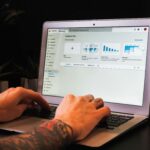As website design and inbound marketing specialists in Melbourne, our job is to make the internet and digital market place a simpler and more effective space for you to do business. With that in mind, let’s tackle a subject that not many business owners know about – Google Analytics – and why it’s pretty essential to your digital marketing efforts.
What is Google Analytics?
Google wants businesses to be online and they want to help businesses reach their customers because ultimately, that’s what makes their company successful. They know you’re specialists in your industry, not theirs, so they help business owners by providing a lot of services and extras that are very helpful for optimising the performance of your website. One of these services is Google Analytics.
It’s just a small piece of code that you can attach to the backend of your website. Once this is done, the programme will start collecting data. Huge amounts of very useful data. Essentially, it monitors your website the way you could monitor a brick and mortar store. It tells you how many people visited your website, how they arrived there, where they went when they got there, and how much time they spent on different pages.
It’s easy to see how this kind of data can be incredibly useful for creating a truly effective and powerful website. And the best part is that it’s all free.
Google Analytics Metrics You Should Know
Metrics is a technical term that covers a certain performance data set that’s associated with actions that occur on your website. If data is a map, then metrics are the key to understanding that map. Here are a few metric terms every business owner should get to know. They’ll help you make informed decisions about where to take your digital marketing next.
- Traffic: This is a fairly self-explanatory metric. It simply means the number of visits to your website. The higher your traffic, the more people are looking at your business online over a set of time. This is a very useful metric because of how you can break it down. Are more people visiting on the weekend or a weekday? Do you get a rush of traffic after you post on social media or after you send out a marketing email? Which pages get the most traffic, and which get none at all? This will help guide the structure of your website and show you which pages need to be improved or where information needs to be added.
- Traffic source: This is an important metric for monitoring your digital marketing campaigns, as it tells you where your traffic is coming from. For example, you could be getting a lot of traffic from your email marketing but not a lot from your social media campaigns. In this case, maybe you need to improve your social media activity or focus on an email marketing campaign for your next promotion. You can also use it to monitor your PPC campaigns, helping you see which keywords are performing and which aren’t doing as well.
- Bounce rate: Your bounce rate will help you understand how many visitors leave your website after viewing a single page. If your bounce rate is low, it means that the majority of users find your website interesting enough to click through to learn more. A high bounce rate is a concern because it means a lot of people aren’t interested in what’s on your website enough to explore further. This could mean that you’re targeting the wrong audience entirely, or that your website content isn’t good enough quality to hold their attention. With a little assistance from a digital marketing and web design team, this can be corrected. We can ensure your website is professional, your content is engaging, and that the whole package looks exactly like what your customers are searching for.
- Exit pages: While no one is going to stay on your website indefinitely, it’s important to know which pages are the last one visitors looked at before they left. These are called exit pages. If you start seeing a trend where say, a new product page is showing a large number of exits, it may indicate that there is an issue with the page. You can evaluate this by checking your pages on different browsers and devices, checking links on the page to ensure all are functional and correct, and evaluating the design of your website against your competitors.
- Top pages: These are the website pages that people spend the most amount of time on, and they’re a great indicator of what is working in your digital marketing strategy for your audience. Sometimes, the results are pretty surprising! When you have a better idea of what works on your website, you can tweak lower-performing pages, or even create campaigns based on the high-performing content. It’s a good idea to find out exactly why these pages are working so well – is it how they are designed? Is the content the right fit for the season? Does it offer a type of content (like how-to videos or a blog) that people are really responding too? All this can help influence your website design and future digital marketing campaigns.
- User behaviour flow, location and age: These metrics provide some great insight into who is visiting your website. Google Analytics knows their age, their geographic location, and even what they do from the moment they arrive on your website until they leave. This information is very useful and can be used as insights on how to tailor your paid search (PPC) and SEO strategies for specific towns. It can also help inform which social media platforms you should consider for marketing your business.
If you’d like an expert eye to professionally analyse your data and give you insights on how to capitalise on the results shown by Google Analytics, contact us and speak to our team of website and inbound marketing specialists. We offer affordable, friendly digital marketing services for businesses in Melbourne and across Australia.

Written by
Murtaza Rangwala - PPC Specialist
I’m all about making your online ads pay. As a PPC pro, I spend my days and nights creating, optimising, and analysing client strategies so they deliver the clicks. With a mix of creative and analytical strategies, I’ll make sure your campaigns land your business the top spot – and that customers see you first.











